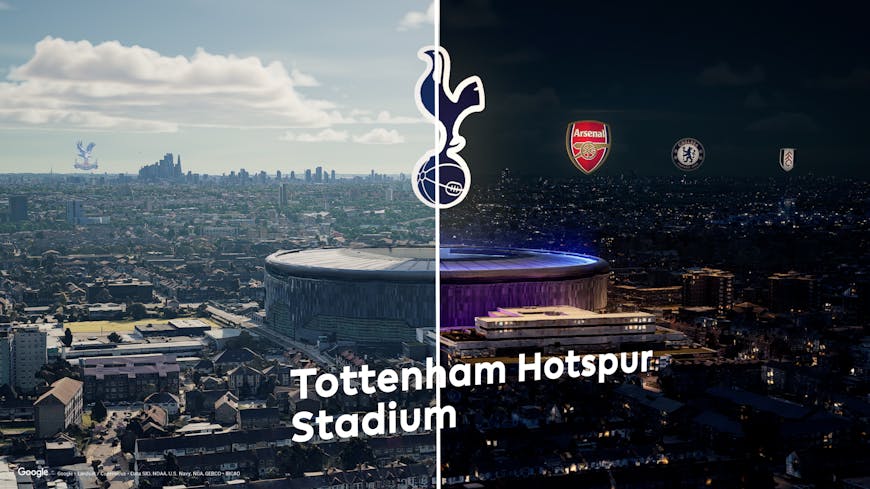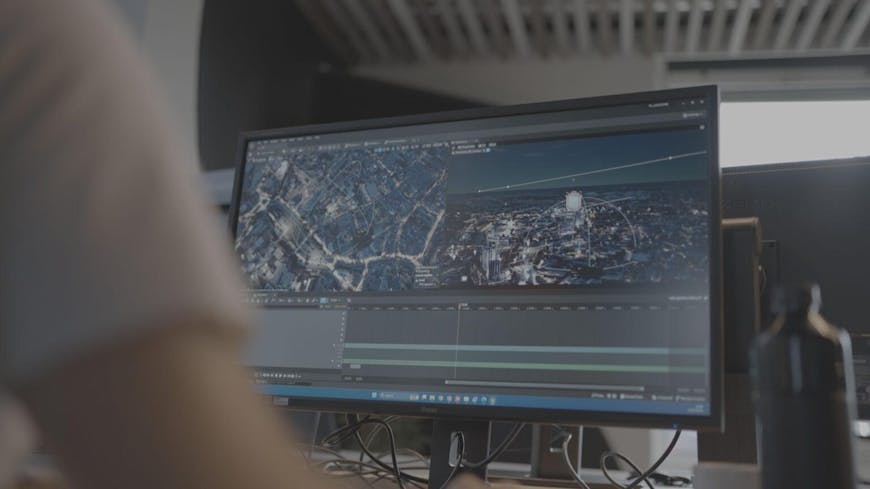Boost Graphics Uses Cesium to Give Premier League's Global Audience a Geography Lesson
The English Premier League reigns supreme among domestic football leagues (soccer in the US), celebrated for its elite talent, fast-paced matches, and unmatched reach. Belgium-based Boost Graphics uses Cesium for Unreal and Google Photorealistic 3D Tiles to create a series of dynamic 3D map animations, known as locators, that provide a fresh perspective on the geography of the league's stadiums across the United Kingdom for a global TV audience of around 3.2 billion.
Boost's locator guiding Premier League's TV audience along the River Tyne to the home of Newcastle United, St. James Park. Courtesy Boost Graphics.
Tim Van Dingenen, Boost’s technical motion design team lead, explained that the locators are part white-knuckle ride and part geography lesson. “Viewers can learn more about the area of England where the game is being played, and the journey there,” he said. “And we wanted their experience to look as good as something you could capture with a drone or helicopter.”
The Premier League approached Boost with the project in June 2023, requiring detailed visualizations for each of the league's 20 stadiums. They sought 80 videos, in short and long formats for varying broadcast time, and both day and night versions to match the time of the match.
And the Premier League required all 80 videos before the start of the 2023-24 season, giving Boost two months to complete the project.

Boost's Premier League locators come in two versions, tailored for use based on timing of the game. Courtesy Boost Graphics.
Boost has been building 3D maps since 2015, starting with visualizations of the Tour de France for European and US broadcasters. Van Dingenen estimates that building those visualizations took 15-30 hours for each of the race's 21 stages to download a mix of satellite and open-source terrain, landscape, and land mass data, including buildings, forests, and water features. Combining and loading the data into the expansive and detailed scenes required 120 gigabytes of RAM.
Creating interactive 3D visualizations became easier for Boost when Google replaced manually modelled buildings with photogrammetry-based models in Google Earth. It became easier, more realistic, and more performant with Cesium for Unreal and Google Photorealistic 3D Tiles.
Built on open standards and APIs, Cesium for Unreal combines the 3D geospatial capability of Cesium with the high-fidelity rendering power of Unreal Engine, unlocking the 3D geospatial ecosystem for game engines. Cesium for Unreal enabled Boost to integrate multiple data formats, including photogrammetry and purchased BIM models, into their Premier League locators. This capability proved particularly useful in visualizing a completed Everton Stadium, which was undergoing construction while Boost was completing their project.
Boost was well covered with the other stadiums. Google Photorealistic 3D Tiles offer high-resolution 3D maps in many of the world's populated areas. “You put in the GPS coordinates of where you want to work, and Cesium just immediately loads in everything,” said Van Dingenen.
Photorealistic 3D Tiles use the Open Geospatial Consortium (OGC) community standard 3D Tiles format. This format, created by Cesium, efficiently streams massive amounts of data.
The Boost team made their deadline, with several days to spare. “We did about 90 days of work in 30 days,” said Van Dingenen. He estimates that Cesium for Unreal and accessing Photorealistic 3D Tiles saved Boost around US $75,000 in labor hours.

Boost's team working with Photorealistic 3D Tiles in Unreal Engine. Courtesy Boost Graphics.
Pairing Photorealistic 3D Tiles with Unreal Engine allowed Boost to replicate natural light, shadows, and fine surface detail viewers would notice in the real world. “We couldn’t have done this without Cesium,” Van Dingenen said while demoing a night fly-over of Everton Stadium, featuring streetlights shimmering off the River Mersey.
Boost Graphics is working on a fresh batch of animations for the 2025-26 Premier League season, which kicks off in August.
Follow the Cesium for Unreal tutorials to bring immersive 3D geospatial to your Unreal Engine projects.